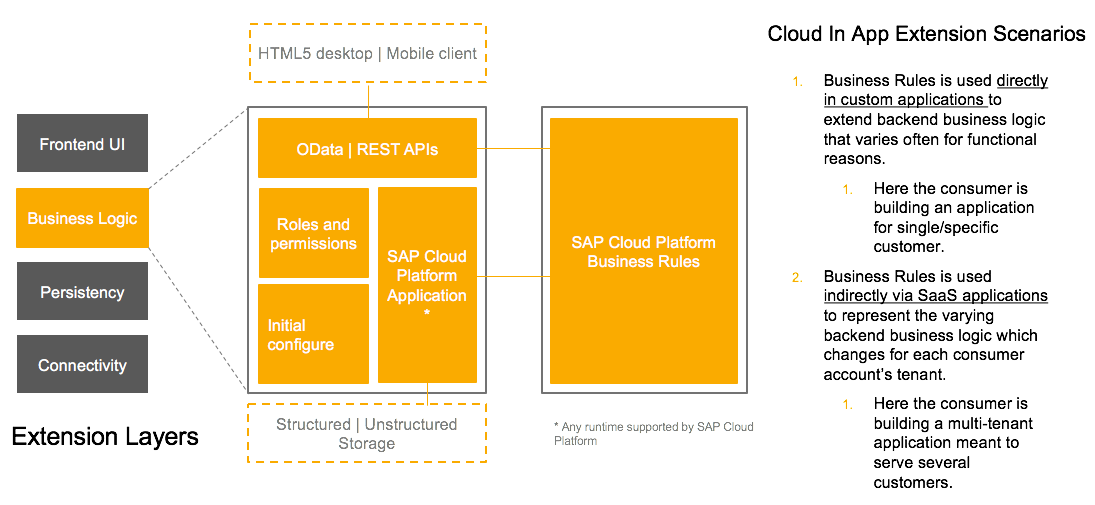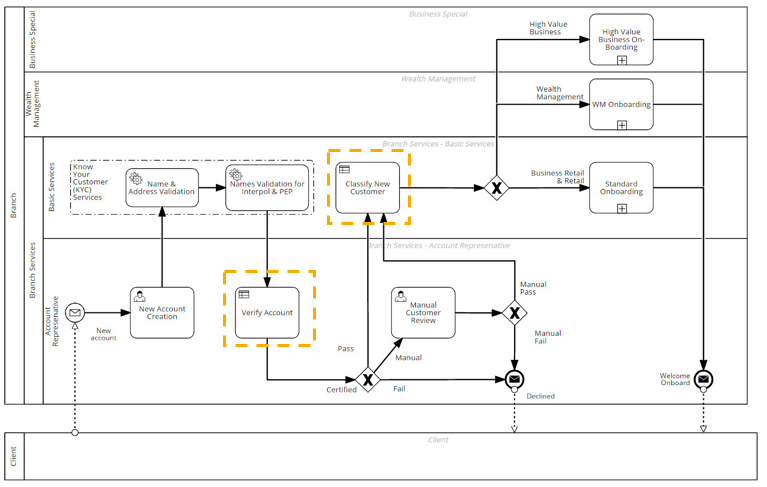
- SAP Community
- Products and Technology
- Technology
- Technology Blogs by SAP
- SAP Cloud Platform Business Rules - Generally Avai...
Technology Blogs by SAP
Learn how to extend and personalize SAP applications. Follow the SAP technology blog for insights into SAP BTP, ABAP, SAP Analytics Cloud, SAP HANA, and more.
Turn on suggestions
Auto-suggest helps you quickly narrow down your search results by suggesting possible matches as you type.
Showing results for
former_member20
Participant
Options
- Subscribe to RSS Feed
- Mark as New
- Mark as Read
- Bookmark
- Subscribe
- Printer Friendly Page
- Report Inappropriate Content
08-23-2017
7:20 PM
We are happy to share the general availability of SAP Cloud Platform Business Rules for productive usage in all SAP Cloud Platform data center. This is the second service covering our BPM Cloud services family and complements SAP Cloud Platform Workflow.
SAP Cloud Platform Business Rules targets line of business users(knowledge experts) and application developers deprived of flexibly changing business decision logic as and when their market conditions or business policies changes. It supports them with a Manage Business Rules Project application to configure a business rules project and capturing the different decision logic required using Decision Table rules and rulesets. The service also offers the Business Rule Management engine as service to invoke the rule service using REST APIs.
The service intends to integrate/aggregate the different rule technologies in SAP like SAP Business Rules Framework plus(BRFplus), SAP Business Rules Management(BRM), SAP HANA Rules Framework(HRF) by providing a common and central rule design time repository for rule authoring, governance, life-cycle management while enabling the flexibility to deploy the rule runtime in the appropriate backend technology like ABAP, HANA, JAVA, there by ensuring the execution of Business Rules in an environment very close to the application logic.
To achieve this vision we have introduced a common meta-model for business rules which is called SAP Enterprise Rule Model. The goal of this model is to simplify the concepts in Business Rules Domain and ensure SAP Customers, Partners, Users, Consultants use ONE approach when they are in need of using business rules in their applications. This model is also aligned with industry standards like Decision Model and Notation to make it open in nature for future contribution from the eco-system.
As of today the service targets two main usage patterns namely

This usage pattern is targeting cloud native applications built on SAP Cloud Platform with a certain backend logic in the cloud for an application area. There are different ways to extend the backend logic e.g the data can be replicated from on premise system and used in the cloud persistency or the backend might involve connectivity to other APIs from on premise and cloud applications. However the most crucial extension layer is the business logic layer that needs to be kept flexible in cloud applications. This business logic layer which involves business decisions are covered by SAP Cloud Platform Business Rules.

This usage pattern is a very common synergy between BPMN and DMN(image Source) where SAP Cloud Platform is used for extending the core processes of a Customer Enterprise system. These process centric extensions uses either SAP Cloud Platform Workflow or SAP Cloud Platform Integration or a combination of both.

In these cases it is a best practice not to hardcode the business decisions in a script task as it forces a Developer to be involved in re-developing the logic when the business requirements changes. Business Rules enables a knowledge expert to directly change the conditions as and when the business policies changes.The developer needs to only introduce the decision interface in the process and provide an execution context for it. Secondly by encapsulating the decision logic in a Business Rule the overall process diagram or process flow is much more simplified and readable.
We have a very exciting roadmap ahead with introduction of other formats of Business Rules like IF-THEN-ELSE text rule, Flow Rule, Formula Rule and also strengthening our Ruleset concept. Besides this we would also share in TechEd 2017 the other usage scenarios we are targeting in
Stay tuned for more updates.
SAP Cloud Platform Business Rules targets line of business users(knowledge experts) and application developers deprived of flexibly changing business decision logic as and when their market conditions or business policies changes. It supports them with a Manage Business Rules Project application to configure a business rules project and capturing the different decision logic required using Decision Table rules and rulesets. The service also offers the Business Rule Management engine as service to invoke the rule service using REST APIs.
Vision
The service intends to integrate/aggregate the different rule technologies in SAP like SAP Business Rules Framework plus(BRFplus), SAP Business Rules Management(BRM), SAP HANA Rules Framework(HRF) by providing a common and central rule design time repository for rule authoring, governance, life-cycle management while enabling the flexibility to deploy the rule runtime in the appropriate backend technology like ABAP, HANA, JAVA, there by ensuring the execution of Business Rules in an environment very close to the application logic.
To achieve this vision we have introduced a common meta-model for business rules which is called SAP Enterprise Rule Model. The goal of this model is to simplify the concepts in Business Rules Domain and ensure SAP Customers, Partners, Users, Consultants use ONE approach when they are in need of using business rules in their applications. This model is also aligned with industry standards like Decision Model and Notation to make it open in nature for future contribution from the eco-system.
As of today the service targets two main usage patterns namely
- In App extension for Cloud Backend
- Decisions for Integration and Orchestration
In App Extension for Cloud Backend

This usage pattern is targeting cloud native applications built on SAP Cloud Platform with a certain backend logic in the cloud for an application area. There are different ways to extend the backend logic e.g the data can be replicated from on premise system and used in the cloud persistency or the backend might involve connectivity to other APIs from on premise and cloud applications. However the most crucial extension layer is the business logic layer that needs to be kept flexible in cloud applications. This business logic layer which involves business decisions are covered by SAP Cloud Platform Business Rules.
- Consider for example a simple Shopping Cart or Web Shop application that provides discounts based on customer purchase. To ensure the Web Shop has a competitive advantage over local promotions the offers needs to change dynamically based on market situation. Here Business Rules can be used for In App extensibility of the cloud application. It is IN APP as business rules enables reorganising the business logic within the application.
- Another example can be a partner application meant for a line of business solution. Here for each customer/tenant of the partner this OEM(Original Equipment Manufacturer) application needs some customisation or business configuration. Business Rules provides this initial business configuration which each tenant or customer of the Partner can setup during application on boarding there by enabling the app developer(Partner in this case) to provide an IN APP extension capability.
Decisions for Integration and Orchestration

This usage pattern is a very common synergy between BPMN and DMN(image Source) where SAP Cloud Platform is used for extending the core processes of a Customer Enterprise system. These process centric extensions uses either SAP Cloud Platform Workflow or SAP Cloud Platform Integration or a combination of both.

In these cases it is a best practice not to hardcode the business decisions in a script task as it forces a Developer to be involved in re-developing the logic when the business requirements changes. Business Rules enables a knowledge expert to directly change the conditions as and when the business policies changes.The developer needs to only introduce the decision interface in the process and provide an execution context for it. Secondly by encapsulating the decision logic in a Business Rule the overall process diagram or process flow is much more simplified and readable.
Next Steps
We have a very exciting roadmap ahead with introduction of other formats of Business Rules like IF-THEN-ELSE text rule, Flow Rule, Formula Rule and also strengthening our Ruleset concept. Besides this we would also share in TechEd 2017 the other usage scenarios we are targeting in
- IoT (Internet of Things) for Data Ingestion and IoT Gateway Edge.
- S4HANA Side by Side extensibility
- Pushing downs rules to HANA database for analytical scenarios
- Transitioning your existing BRFplus projects to SAP Cloud Platform Business Rules.
Stay tuned for more updates.
11 Comments
You must be a registered user to add a comment. If you've already registered, sign in. Otherwise, register and sign in.
Labels in this area
-
ABAP CDS Views - CDC (Change Data Capture)
2 -
AI
1 -
Analyze Workload Data
1 -
BTP
1 -
Business and IT Integration
2 -
Business application stu
1 -
Business Technology Platform
1 -
Business Trends
1,661 -
Business Trends
87 -
CAP
1 -
cf
1 -
Cloud Foundry
1 -
Confluent
1 -
Customer COE Basics and Fundamentals
1 -
Customer COE Latest and Greatest
3 -
Customer Data Browser app
1 -
Data Analysis Tool
1 -
data migration
1 -
data transfer
1 -
Datasphere
2 -
Event Information
1,400 -
Event Information
64 -
Expert
1 -
Expert Insights
178 -
Expert Insights
273 -
General
1 -
Google cloud
1 -
Google Next'24
1 -
Kafka
1 -
Life at SAP
784 -
Life at SAP
11 -
Migrate your Data App
1 -
MTA
1 -
Network Performance Analysis
1 -
NodeJS
1 -
PDF
1 -
POC
1 -
Product Updates
4,577 -
Product Updates
323 -
Replication Flow
1 -
RisewithSAP
1 -
SAP BTP
1 -
SAP BTP Cloud Foundry
1 -
SAP Cloud ALM
1 -
SAP Cloud Application Programming Model
1 -
SAP Datasphere
2 -
SAP S4HANA Cloud
1 -
SAP S4HANA Migration Cockpit
1 -
Technology Updates
6,886 -
Technology Updates
398 -
Workload Fluctuations
1
Related Content
- Capture Your Own Workload Statistics in the ABAP Environment in the Cloud in Technology Blogs by SAP
- generating qrcode using image url in crystal report in Technology Q&A
- Empowering Retail Business with a Seamless Data Migration to SAP S/4HANA in Technology Blogs by Members
- 10+ ways to reshape your SAP landscape with SAP Business Technology Platform - Blog 7 in Technology Blogs by SAP
- 10+ ways to reshape your SAP landscape with SAP BTP - Blog 4 Interview in Technology Blogs by SAP
Top kudoed authors
| User | Count |
|---|---|
| 11 | |
| 10 | |
| 9 | |
| 9 | |
| 7 | |
| 7 | |
| 7 | |
| 6 | |
| 6 | |
| 5 |